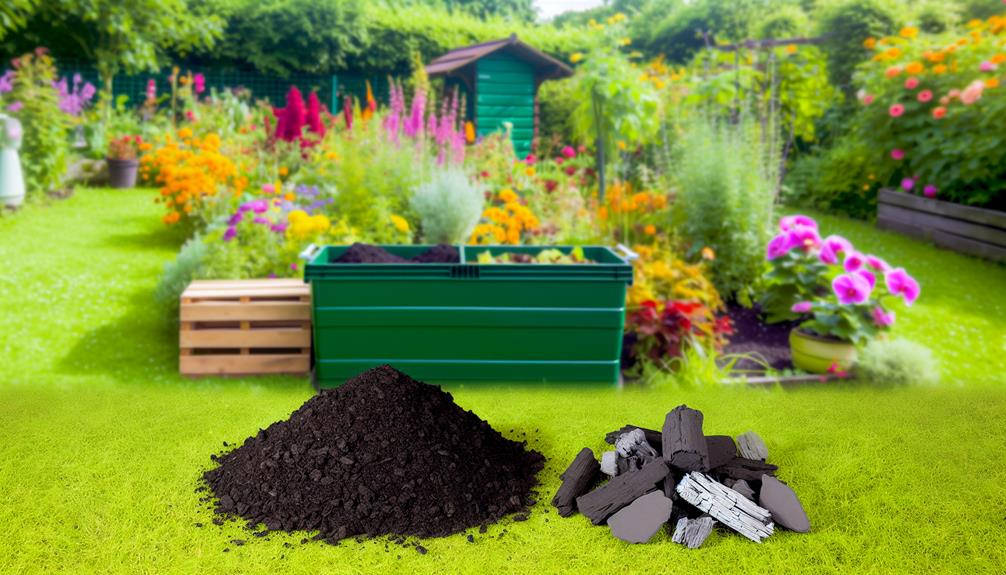

Yes, you can compost ash from natural lump charcoal, but you need to be cautious. Natural lump charcoal ash contains minerals like potassium, calcium, and magnesium, which can benefit soil. However, its high pH can maintain compost balance. Add ash sparingly—no more than one cup per 20 square feet of compost.
Cool the ash completely, sift it to remove unburned pieces, and mix thoroughly to prevent compaction. This guarantees the ash is effectively absorbed. Handling ash with gloves and a mask protects you from fine particles. Follow these steps to safely compost ash and explore other sustainable uses for it.
When composting ash from natural lump charcoal, you need to take into account its mineral content, which includes essential nutrients for plants.
The pH level of the ash can greatly impact soil acidity, potentially making it more alkaline.
Additionally, check for the presence of any heavy metals that could adversely affect your compost and garden soil.
Charcoal ash primarily contains minerals like potassium, calcium, and magnesium, which can enrich your compost. These minerals are crucial for plant growth. Potassium helps with root development, calcium strengthens cell walls, and magnesium is essential for photosynthesis.
To maximize these benefits, mix the ash thoroughly into your compost pile.
However, you should use charcoal ash in moderation. Adding too much can lead to an imbalance in your compost’s nutrient content. It’s a good idea to sprinkle a thin layer of ash over your compost and then mix it well. This guarantees even distribution and prevents clumping.
Always make sure the charcoal is from natural lump sources, free from additives or chemicals that could harm your compost.
In addition to its mineral benefits, charcoal ash can greatly impact the pH level of your compost. Charcoal ash is highly alkaline, meaning it can raise the pH level of your compost. This is important if your compost is too acidic.
To make the most of charcoal ash:
You should be aware that natural lump charcoal ash might contain trace amounts of heavy metals, which can affect your compost’s safety and quality. Elements like cadmium, lead, and arsenic could be present, albeit in very small amounts. While these metals are naturally occurring, introducing them into your compost can pose risks, especially if you plan to use the compost for growing edible plants.
To mitigate this, always use lump charcoal labeled as ‘natural’ and free from additives. It’s also wise to limit the amount of ash you add to your compost. A small percentage, around 5% of your total compost volume, is usually safe. Regularly testing your soil for heavy metals can help make sure your compost remains safe and healthy.
Also Read: Can You Compost Batteries?
Not only does charcoal ash enrich your compost pile with valuable nutrients, but it also helps to balance pH levels in the soil. By adding charcoal ash, you’re enhancing the fertility of your soil, making it more conducive to plant growth.

Here are some specific benefits:
Use these advantages to maintain a thriving garden!
While charcoal ash offers numerous benefits, it’s equally important to be mindful of potential risks when adding it to your compost. One significant risk is the high pH level of ash, which can make your compost too alkaline. This shift can disrupt the microbial balance, slowing down the composting process.
Additionally, ash can contain trace amounts of heavy metals, which might accumulate in your compost and eventually in your plants. Another concern is that ash can compact easily, creating dense layers that impede airflow and moisture circulation.
To mitigate these risks, always mix ash thoroughly with other compost materials and use it sparingly. Balancing ash with other components promotes a healthier, more effective compost.
Before adding ash to your compost, make sure it’s completely cool to prevent any fire hazards.
Once the ash is cool, sift it to remove any larger charcoal chunks that haven’t fully combusted. These pieces can take a long time to break down and may hinder your composting process.
Store the sifted ash in a dry container until you’re ready to use it, ensuring it doesn’t get wet, which could lead to clumping and make it harder to distribute evenly.
Sift the ash to remove unburned charcoal pieces.
Store in a dry container to avoid moisture.
Ensure complete cooling to prevent fire hazards.
Also Read: Can You Compost Agave?
To add ash to your compost, start by ensuring it has completely cooled and then screen out any large chunks.
Mix the ash thoroughly with brown materials like dried leaves or straw to balance the compost.
Regularly monitor the pH levels to maintain an ideal environment for decomposition.
After the charcoal has completely burned out, let the ash cool for several hours before handling it. This step is important to guarantee safety and prevent accidental burns.
Once the ash is cool, screen it to remove any large chunks or unburned pieces. Use a fine mesh sieve to separate the fine ash from larger debris.
Safety First: Always wear gloves and a mask to avoid inhaling ash particles.
Efficient Screening: A mesh sieve or old window screen works well for filtering out larger bits.
Storage Tips: Store the screened ash in a metal container with a lid until you’re ready to add it to your compost.
Following these steps ensures that the ash is safe and ready to be incorporated into your compost pile.
Consistently mix the cooled ash with brown materials like dried leaves, straw, or cardboard to create a balanced compost.
Start by spreading a thin layer of ash over your compost pile. Then, add a thicker layer of brown materials on top. This layering helps maintain the right carbon-to-nitrogen ratio, essential for effective composting.
Make sure to turn your compost regularly to guarantee the ash is evenly distributed. It’s important not to overdo it with the ash; a small amount goes a long way. Too much ash can make your compost too alkaline, which might affect plant growth.
Aim for a mix that’s about 1 part ash to 10 parts brown material. This balance fosters a healthy compost environment.
Regularly check the pH levels of your compost to make sure the ash isn’t making it too alkaline. You’ll want to aim for a pH between 6.0 and 7.5. Use a soil pH test kit to monitor changes.
If the pH starts to rise, add more brown materials like leaves or straw to balance it out. Remember, moderation is key when adding ash.
Test Frequency: Check the pH weekly initially, then monthly once stable.
Neutralizing High pH: If the compost becomes too alkaline, add acidic materials like pine needles or coffee grounds.
Ash Quantity: Limit ash to small amounts; overuse can harm beneficial microbes and slow decomposition.
Keep these tips in mind to maintain a healthy compost balance.
Deciding on the ideal ash quantity for composting guarantees you don’t overwhelm your compost pile. Start by adding ash in small amounts. Too much ash can make the pile too alkaline, disrupting the composting process.
A good rule of thumb is to use ash sparingly—no more than one cup of ash for every 20 square feet of compost. Mix it thoroughly to secure even distribution.
Remember, ash is rich in potassium and can improve soil quality when used correctly. However, excessive ash can also hinder the breakdown of organic materials.
Always monitor your compost’s pH levels to maintain balance. By carefully managing ash quantities, you can enhance your compost without causing harm.
While managing compost’s ash content is important, there are several other practical uses for the ash from natural lump charcoal. You can utilize it in your garden and home in various ways to maximize its value.
These methods not only repurpose the ash effectively but also contribute to a more sustainable lifestyle.
Also Read: Can You Compost Bacon?
When managing ash from natural lump charcoal, always wear gloves and a mask to protect yourself from potential irritants. Charcoal ash can be dusty and may contain fine particles that are harmful if inhaled.

Store the ash in a metal container with a tight-fitting lid to prevent accidental spills and potential fire hazards. Make sure the ash is completely cool before handling or storing it.
If you’re transferring ash to your compost, do it slowly to minimize dust. Avoid handling it on windy days to prevent it from blowing around. Keep children and pets away from the area where you handle ash.
To safely compost ash from natural lump charcoal, it’s important to ensure that it’s free of chemicals and treated wood. Mix small amounts of ash into your compost to help balance pH levels and introduce essential minerals into the mix.
Always remember to sift the ash before adding it to the compost to remove any large chunks that may not break down effectively. Additionally, moistening the ash can help reduce dust and make it easier to incorporate into the compost pile.
Moderation is key when adding ash to your compost. Too much ash can have negative effects and harm the composting process. Consider using ash as a soil amendment or even as a pest deterrent in your garden as an alternative way to utilize it effectively.
Lastly, handle ash with care to avoid inhalation or skin contact. By following these guidelines, you can safely and effectively incorporate ash from natural lump charcoal into your composting routine.
